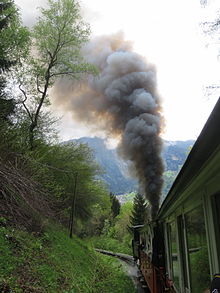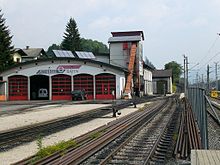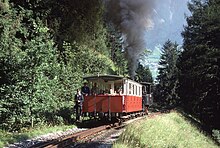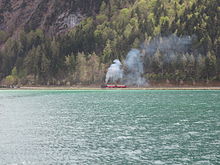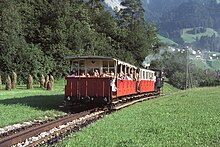Achenseebahn
| Jenbach-Seespitz am Achensee | |||||||||||||||||||||||||||||||||||||
|---|---|---|---|---|---|---|---|---|---|---|---|---|---|---|---|---|---|---|---|---|---|---|---|---|---|---|---|---|---|---|---|---|---|---|---|---|---|
|
Seespitz train station on the Achensee
| |||||||||||||||||||||||||||||||||||||
| Course book route (ÖBB) : | 311 | ||||||||||||||||||||||||||||||||||||
| Route length: | 6.80 km | ||||||||||||||||||||||||||||||||||||
| Gauge : | 1000 mm ( meter gauge ) | ||||||||||||||||||||||||||||||||||||
| Maximum slope : |
Adhesion 25 ‰ rack 160 ‰ |
||||||||||||||||||||||||||||||||||||
| Minimum radius : |
Adhesion 100 m rack 120 m |
||||||||||||||||||||||||||||||||||||
| Rack system : | Riggenbach | ||||||||||||||||||||||||||||||||||||
|
|||||||||||||||||||||||||||||||||||||
Coordinates: 47 ° 23 ′ 20.4 " N , 11 ° 46 ′ 45.6" E
The Achenseebahn ( ) is a narrow-gauge rack railway in Austria in meter gauge . It leads from Jenbach to Seespitz am Achensee and was opened in 1889. The route is not electrified , is only used by steam locomotives according to the schedule and is mainly used for tourism purposes.
On March 25, 2020, Achenseebahn AG had to file for insolvency at the Innsbruck Regional Court because of insolvency after the State of Tyrol refused to provide further financial support. Due to the bankruptcy, continued operation is uncertain, even if the neighboring communities want to continue to campaign.
At the end of May 2020, Austria was also considering nominating the Achenseebahn as a UNESCO World Heritage Site.
history
In 1886, consul Theodor Friedrich Freiherr von Dreifuss from Grüneck applied to the village of Kreuth in Upper Bavaria for a concession for a cog railway and railroad connection from Jenbach in the Inn Valley to the southern tip of the Achensee. Despite the concerns of the lakeside residents about this then newfangled rack railway, after approval by the Fiecht Monastery , which owned the Achensee and operated steam shipping on it, on August 1, 1888 , Emperor Franz Josef the First granted the concession to build and operate a narrow-gauge locomotive railway with mixed adhesion - and rack rails operation for ninety years. The certificate with the imperial seal, some of which is handwritten in gold, is still intact in the possession of the Achenseebahn.
On June 8, 1889, the originally 6.36 kilometer long route was officially opened, but ended a few hundred meters earlier than today, at the old station buildings of the Achenseebahn, which are still standing today. A tugboat with a gauge of 600 millimeters led to today's Seespitz station and thus the steamboat landing stage. In 1916, the Austrian military administration had the towing track gauged to 1000 millimeters, although the locomotives were not allowed to use this section of the route. The Achenseebahn was finally able to acquire the track and use its trains from July 23, 1929. The route was thus extended to 6.76 kilometers. Since then, there has been a new station building and a new steamboat dock at the new Seespitz / Achensee terminus. After reconstruction in 1971 to adapt it to current needs, this system still exists today. In 2012 the Maurach-Mitte stop was put into operation. In 2013, the then operations manager was released early; since then there has been a lawsuit. Since autumn 2018, the continued existence of the Achenseebahn AG has been at risk due to the desolate route, desolate vehicles and financial problems, but it was still possible to drive in the 2019 season. However, insolvency proceedings were opened in early 2020. The country agreed to save the railway, but operation is not conceivable until 2021.
Ownership
The owner and operator is Achenseebahn AG, whose capital is 30.2 percent in the hands of the neighboring communities.
In 1950 the Tiroler Wasserkraftwerke AG (TIWAG) held the majority of the shares. In 1979 the surrounding communities took over this. Now the flat stretch has been rehabilitated with the help of the federal and state governments. The communities of Eben , Jenbach and Achenkirch have been the main shareholders since 1991. In 2009 the share capital of the AG was increased, since then the three municipalities have only 30.2 percent of the share capital instead of 70 percent. In January 2019, the Tyrolean state government applied to the state parliament for a grant of 1.2 million euros to the municipalities of Eben, Jenbach and Achenkirch in order to provide the municipalities with more than half of the property again by way of a capital increase; the money was used for the most urgent measures, without which the operation in the 2019 season could not have been carried out.
Expansion plans: extension and local transport
Local public transport is largely served by buses. There are, however, plans to change that. In the course of an upcoming route renovation, the possibility of an expansion to a modern electric regional train and an extension to Pertisau should also be considered. The infrastructure is to be designed in such a way that steam train operation at hourly intervals with temporary compression in the main season to Seespitz is possible together with electrical operation over the entire route. The idea is to operate with an electric multiple unit . Suitable vehicles could be taken over from the Appenzeller Bahnen in Switzerland. They should enable travel times of eight minutes from Jenbach to Eben and 25 minutes from Jenbach to Pertisau.
Route description
Jenbach train station
The almost seven-kilometer route begins at Jenbach station , the only Austrian station with three different gauges. This is where the standard gauge ÖBB , the 760 mm narrow gauge of the Zillertal Railway and the meter gauge of the Achensee Railway meet .
Jenbach – Eben cogwheel route
The steep section from Jenbach up to Eben is equipped with a ladder rack according to the Riggenbach system, as a maximum gradient of 160 per mille has to be overcome here. On the steep section, the locomotive must always be lined up on the valley side of the train, so the trains from Jenbach to Lake Achensee are pushed to Eben.
Flat route from Eben to Seespitz / Achensee
In Eben the locomotive bypasses the train and then pulls it without a gear on a gentle slope past Maurach to Seespitz on the banks of the Achensee. There is a connection to the Achensee-Schifffahrt ships. In Seespitz, the train moves again, so that the sidecars are pulled to Eben and there is no need to move.
Resources
Locomotives
For the opening of the Achenseebahn in 1889, four cogwheel steam locomotives with the Bzt-n2 wheel arrangement were procured. They were given the numbers 1 to 4 and the names Theodor, Hermann, Georg and Carl . Locomotive 4 was used as a spare parts donor in the years after the Second World War and was subsequently scrapped. Until 2005, operations were run exclusively with the three remaining machines, which are considered to be the oldest cog railway locomotives in Austria. In 2005, a reconstructed locomotive 4 from reconditioned old components of the other machines and some spare parts was heated up again for the first time. However, it only served as a standing film set and some important parts were still missing to be able to put it into operation. After locomotive 1 was badly damaged in a fire in the boiler house in Jenbach on May 16, 2008, locomotive 4 was then made ready for use within three months with undamaged parts of locomotive 1, so that initially three locomotives were still available. The damaged locomotive 1 was rebuilt by the end of 2009 and has been operational again since then. A planned oil firing was abandoned because of bad experiences with the Zillertalbahn and Schafbergbahn .
dare
Seven two-axle passenger cars were available for the opening. Four open summer wagons (1–4) were built in 1889 by the Wagen- und Waggonfabrik, iron and metal foundry Joh. Weitzer from Graz, three closed wagons came in 1888 from the Gaisbergbahn. In 1903 and 1907 two of the Gaisberg wagons and new parts from Weitzer were used to build the 5 and 6 closed passenger cars that are still in existence today. The third Gaisberg wagon was initially converted into a freight wagon in 1926. In 2001 it was returned to its original condition as Salon Car 7,
A train normally consists of a closed car and an open summer car , which are pushed uphill to Eben and from there to Seespitz.
Between 1889 and 1926, the Achenseebahn procured a total of 12 freight cars for freight traffic, all but two of which were decommissioned between 1956 and 1973. The two wagons that are still in existence today are used for internal transports; there is no longer regular freight traffic on the Achensee Railway.
Push-pull trains of the Appenzeller Bahnen
On 11/12 June 2018 the BDeh 4/4 11 and 12 were brought by the Appenzeller Bahnen for the planned use on the Achenseebahn to Jenbach . In autumn 2018, the remaining railcars 13–15 and the associated control cars ABt 111–115 followed. The vehicles were sold for a symbolic price. A few weeks after delivery and installation on a temporary track, the vehicles were defaced with graffiti .
If the electrification of the Achenseebahn does not come about, the rack-and- pinion railcars are to be equipped with a hybrid drive . Given the tight financial situation of the Achenseebahn, it is questionable whether one of the two expensive options will come about. The suitability of the railcars on the much steeper Achenseebahn is unclear (Achenseebahn 160 ‰ vs. Appenzeller Bahn 100 ‰).
literature
- A. Chvatal: Great history of a small railway - Achensee steam cog railway 1889–2014. Self-published by Pro Arte, Jenbach 2014.
- W. Duschk, W. Pramstaller and others: Local and trams in old Tyrol. Self-published by Tiroler MuseumsBahnen, Innsbruck 2008.
- Karl Armbruster, Hans Peter Pawlik: Jenbach-Achensee, the Tyrolean rack railway. Slezak publishing house, Vienna 1993, ISBN 3-85416-149-2 .
- Arthur Meyer, Josef Pospichal: Rack railway locomotives from Floridsdorf. Verlag bahnmedien.at, Vienna 2012, ISBN 978-3-9503304-0-3 .
- Karl Armbruster: The Tyrolean mountain railways . Buchdruckerei G. Davis & Co., Vienna 1914, Die Achenseebahn, p. 59–70 ( digitized version from the South Tyrolean regional library [accessed on September 15, 2017]).
- Save the Achenseebahn! In: Railway courier . No. 7 , July 2020, ISSN 0170-5288 , p. 30-35 .
Web links
- Homepage of the Achenseebahn
- Tyrolean museum railways
- Entry on Achenseebahn in the Austria Forum (in the Heimatlexikon)
Individual evidence
- ^ LG Innsbruck, 19 S 23 / 20k - bankruptcy proceedings - Achenseebahn-Aktiengesellschaft. Retrieved April 8, 2020 .
- ^ ORF: Achenseebahn in bankruptcy. ORF Tirol, March 25, 2020, accessed on March 25, 2020 .
- ↑ Heritage Alert Achenseebahn. icomos.at, accessed on May 24, 2020 (German).
- ↑ tirol ORF at red: Achenseebahn is to become a UNESCO World Heritage Site. May 24, 2020, accessed May 24, 2020 .
- ↑ tt.com
- ↑ Fankhauser Eva-Maria: Achenseebahn: “Marchi is ready to return”. In: Tyrolean daily newspaper. May 19, 2018, accessed December 4, 2018 .
- ↑ Fankhauser Eva-Maria: Achenseebahn process steams up and down. In: Tyrolean daily newspaper. September 27, 2018, accessed December 4, 2018 .
- ↑ Zwicknagl Walter: The Achenseebahn is about to end in 2019. In: Tyrolean daily newspaper. October 8, 2018, accessed December 4, 2018 .
- ^ Dähling Angela: Achenseebahn: Cross-party cry for lifeline. Tiroler Tageszeitung, December 1, 2018, accessed on December 4, 2018 .
- ↑ Austria: 1.2 million euros to ensure the Achenseebahn's rail operations in 2019 on lok-report.de
- ↑ Salzburger Nachrichten, May 27, 2020, Achenseebahn: The points are about to be renovated
- ↑ a b The museum railway: magazine for small railway history . No. 1 . DME Selbstverlag, 2015, ISSN 0936-4609 , p. 8 .
- ↑ History of the Achenseebahn on achenseebahn.at
- ↑ Austria: 1.2 million euros to ensure the Achenseebahn's rail operations in 2019 on lok-report.de
- ↑ gwa: KBS 311 Jenbach - Achensee boat station. In: IBSE telegram. 298 (9/2015), p. 4.
- ↑ Future of the Achenseebahn . On: Homepage of the Achenseebahn.
- ↑ orf.at
- ↑ Dähling Angela: Achenseebahnflotte completely, no to conversion to oil. In: Tyrolean daily newspaper. October 20, 2018, accessed December 4, 2018 .
- ↑ Dähling Angela: Achenseebahn prefers soot to fine dust. In: Tyrolean daily newspaper. October 25, 2018, accessed December 4, 2018 .
- ↑ a b A. Huber, M. Rellstab: AB vehicles to Austria. In: Swiss Railway Review . No. 8-9. Minirex, 2018, ISSN 1022-7113 , p. 402.
- ↑ Martin Schneider: Next stop at the scrap yard: This happens to the old Appenzeller Bahnen trains. In: St. Galler Tagblatt (online) of August 27, 2018
- ↑ Great damage from the act of vandalism. In: tirol.orf.at. November 30, 2018, accessed December 4, 2018 .


